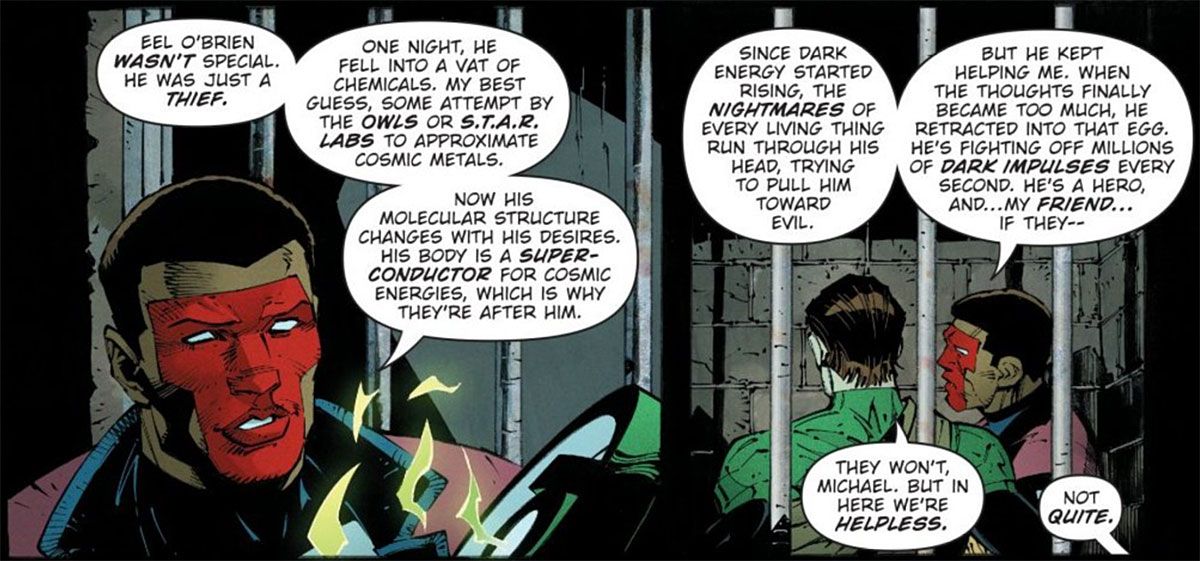SPOILER WARNING: The following article contains major spoilers for Dark Nights: Metal #5 by Scott Snyder and Greg Capullo, on sale now.
If there were ever a character origin that could've been left alone, it would be Plastic Man's, right? After all, it's not like fans were clamoring for a new one. His wasn't the only career initiated by exposure to a pool of toxic chemicals, and if it was good enough for The Joker, Flash, and Swamp Thing, then why not the far less-prolific and long-neglected Eel O'Brian?
Perhaps because Plastic Man has long been neglected and under-utilized. Scott Snyder and Greg Capullo's Dark Nights: Metal #5 puts forth an expansion of Plas' origin -- and if there's one character whose origin can appropriately be stretched a bit, it's Plastic Man's. Fans will recall creator Jack Cole's original beginnings for his villain-turned-hero featured a botched robbery that not only gave him his catalytic chemical bath, it also set him on the road for becoming a hero.
RELATED: It’s Looking More and More Like Bendis Will Write Batman… and Plastic Man
Snyder honors that legacy by leaving Plans' origin story fully intact. He also elevates it by adding possible connections to the entirety of the DC Comics Universe, itself recently expanded by the events of Metal. Cole's version simply featured Eel robbing the inconsequential and throwaway Crawford Chemical Works, a mere story device of convenience. Snyder, though, jettisons CCW and comes up with a possible setting that's far more relevant.
As told to Hal Jordan by Mr. Terrific, Eel had fallen not into just any vat of chemicals, but into a concoction that he believes was an attempt to replicate the cosmic metals of the DC Universe. He speculates on two possible entities as the parties responsible for the chemicals: either the Court of Owls, or S.T.A.R. Labs. Both organizations certainly hold more significance to the overall DCU than the benign and forgotten Crawford Chemical Works.
It was the Court of Owls, of course, that manufactured Batmanium, the last of the five heavy metals needed to complete the mantling process that opened the gateway to the Dark Multiverse. It was Batman himself who endured this process in Metal #2. Generations earlier, the Owls had also demonstrated familiarity with another of those metals, Electrum, which they used to resurrect the Court's Talons from the dead.
RELATED: Is Brian Michael Bendis Dropping Clues For His First DC Comics Project?
The Court of Owls having a claw in Plastic Man's origins seems like a definite possibility within the context laid out over the course of Metal. If Mr. Terrific's theory is correct, the Owls may have been attempting to manufacture one of the other three metals. This could mean that Plastic Man took a bath in a derivative of Promethium, prime element in the cybernetic makeup of Victor Stone, aka Cyborg. Or possibly Dionesium, which was responsible for resurrecting Batman and The Joker after "Endgame." He could also have been exposed to an approximation of Nth Metal itself, connecting him even closer to Metal, and thus establishing the reasons for Plastic Man's still unexplained importance to the series. Regardless, all of the above scenarios give Plas a meaningful connection to the DCU that didn't exist before.


